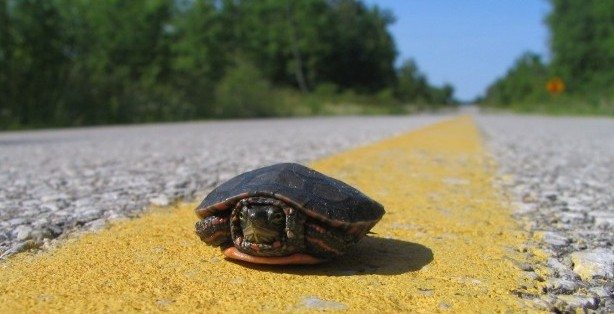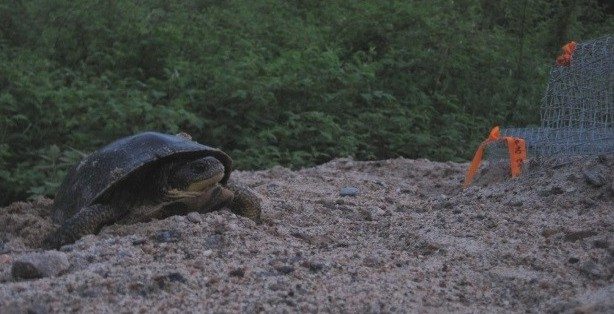Ontario Nature Blog
Receive email alerts about breaking conservation
and environmental news.
© Lora Denis
Slow-moving turtles are some of the most threatened wildlife in the province. Seven of Ontario’s eight species are at-risk, in large part due to roadkill. Most of the turtles found dead and injured on roads are females in search of nesting sites.
In southern Ontario, there are over 35,000 kilometres of roads. No matter where you stand, a road will be no more than 1.5 kilometers away. This is great if you are a driver, but not so great if you are a turtle.

Turtles like to nest in sandy soils found in sunny locations so that their eggs remain warm enough to hatch. Often, females will travel several kilometers and cross multiple roads to find suitable nesting sites.
What if turtles did not have to cross roads to find nesting sites? Would this reduce the number of adult females and hatchlings hit by cars? Would this also increase the number of turtles recruited into a population by improving the success of nests? Could artificial nesting mounds placed in safe locations reduce turtle mortality and increase population recruitment? In 2009, we initiated a research project to answer these questions.
To increase the likelihood of turtles finding and using artificial nesting mounds, conservation biologists need to predict the paths of female turtles and place multiple mounds along those paths. With help from Ontario Parks and the Algonquin Forestry Authority, we constructed four nesting mounds in safe locations in Algonquin Provincial Park. The mounds were made of sand and gravel, the same mix used on roadsides.
We hypothesized that artificial nesting mounds would be effective conservation tools for turtles because natural nesting sites, such as sandy beaches, are rare and artificial nesting mounds can mimic natural sites.
We tested three criteria that needed to be satisfied for the hypothesis to be supported:
Female turtles were indeed able to find the artificial nesting mounds. We found four nests on the mounds, which was more than expected based on the area of the mounds relative to the area of natural nesting sites. Moreover, when we used observations of females walking from wetlands to natural nest sites to estimate paths females would need to take to encounter the mounds, we determined that females were actually unlikely to have walked across the mounds. This suggests that we could have increased the number of nests on mounds if we had placed them where females were more likely to encounter them.

We also found that hatching success and conditions in the artificial nesting mounds were equivalent to or improved from those found in natural nesting sites. We compared the hatching success of eggs laid in mounds with those in natural nests by carefully removing half the eggs found in clutches in natural nests and burying them in the mounds. Nest success was higher in the mounds (93 percent success rate) than in natural nests (56 percent success rate), and the incubation conditions, such as temperature, were the same in the mounds as they were at natural sites chosen by female turtles. This suggests that artificial nesting mounds can promote successful recruitment into a population by improving the success of nests.
Our research demonstrates that artificial nesting mounds – if properly placed – can reduce the negative impact of roads on turtle populations. Also, attracting females to artificial nesting mounds may increase nest success. It is exciting to consider how this simple and inexpensive intervention can help protect and restore at-risk turtles turtle populations in Ontario .
For more details of our research, read “Not just any old pile of dirt: evaluating the use of artificial nesting mounds as conservation tools for freshwater turtles.”
For a historical look at the implication of roads on protected areas, read this paper by Fenech, Taylor, Hansell and Whitelaw.
Visit the Ontario Reptile and Amphibian Atlas website to learn more about Ontario’s herpetofauna.
By
James Paterson is a PhD student at the University of Ottawa. His research focuses on the habitat selection, conservation biology and ecology of reptiles.
Dr. Jacqueline Litzgus is a professor at Laurentian University in Sudbury. Her research focuses on the application of scientific rigor to inform species-at-risk recovery. She has a deep affinity for turtles and snakes.

Gananoque Lake Nature Reserve © Smera Sukumar
I am here in the area through August 20th. I was fonttraue enout to see one nest of turtles hatch. My cousin and I are thinking about volunteering nest summer. I am just wondering what the expected hatch dates are and at what locations.I would love to be there again. I ws so thrilled that I got to share the experience with my sister and her daughter on their 2nd night visiting.
This is one of the great initiations taken to protect the extinction of the creatures. Protecting the turtle from the road accidents by building artificial nesting mounds with specifications of a natural nesting sites. And also, it is good to see the Nest success rate of 93 percent against the natural Nests success rate of only 56 percent. These conservation biologists are protecting and restoring at-risk turtle population in Ontario.
This is such a simple, smart solution. This looks like truly human caretaking to me.
I wonder if there is a learning curve for their predators? Once they find a mound or recognise mounds in general, they may focus their predation and be more successful, especially in high Raccoon/Red Fox/Striped Skunk/Coyote areas. Clumping the resource (i.e., turtle eggs) could ultimately provide a local convenience store for these guys.
In North Frontenac where we live there is a certain area where we have seen the woodland turtle quite often but has now been planted in red pine .
Do you think this will affect the Blanding turtle? (Is this also called the Woodland turtle?)
Hi Carol,
Blanding’s turtles and wood turtles are two separate species. You can learn more about Ontario’s turtles here: https://www.ontarionature.org/protect/species/reptiles_and_amphibians/index.php.
Depending on if the shoreline was significantly disturbed, it may disrupt the turtle’s welfare, but most turtles have not emerged yet, especially in your region and the turtles will likely return to the shoreline. Blanding’s turtles begin to nest in late May or early June.
ON Noah,
Communications Assistant
This is a very interesting article. What species of turtles nested in the mounds? What was the racoon population in the area? We have turtles that cross a concession road to enter our property and have laid their eggs along the laneway, in our plant & vegetable gardens and throughout the hundred acre property. Sadly the racoons will actually sit there and wait for the last egg to be buried .. and dig them up while they are warm. Last year we attached thorny branches to chicken wire and were able to protect some of the snapping turtle nests … still had ~ 50 nests dug up by the racoons. Two observations about ‘helping turtles cross the road” … public education is needed to address how the endangered Snapping turtle should be picked up & if driving past a wetland area …. Turtle Crossing signs are needed and motorists need to know that following too closely can cost the life of a turtle … as there’s not enough reaction time to avoid hitting the turtle. Thank for the information.
Thanks for your note Cheryl. James Paterson has provided the following reply:
– Blanding’s turtles, painted turtles and snapping turtles used the mounds.
– The raccoon population is low in the area where we constructed the mounds.
Is nest predation of constructed mounds a problem?
What is the advantage of a mound over digging pit and filling it with gravel and sand?
Thanks for the information.
Thanks Tim.
James Paterson replied that he does not know if predation is a problem on the mounds more or less so than it is for natural nests. He removed the effect of predators by caging all nests, and says that this should be tested before widespread implementation of nesting mounds.
James also replied that the main advantage of a mound over a pit is cost. For a mound, you simply dump material. For a pit, you have to dig a hole before dumping.